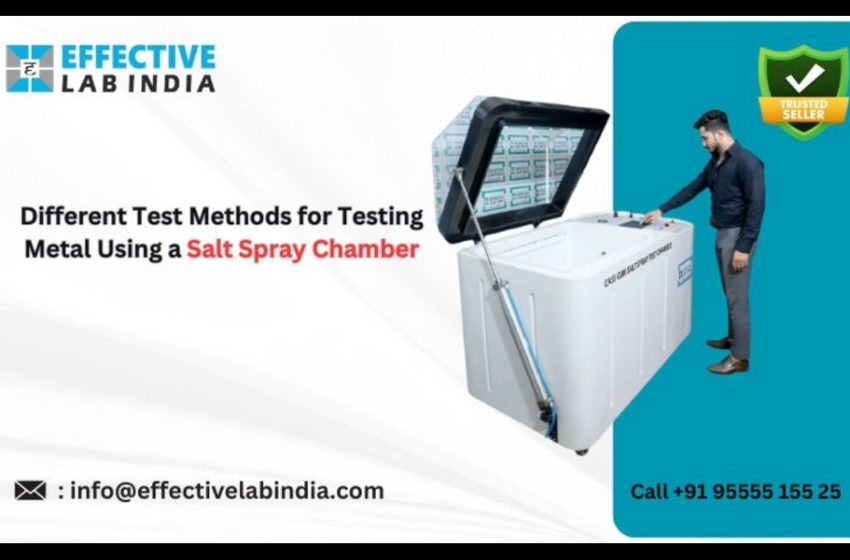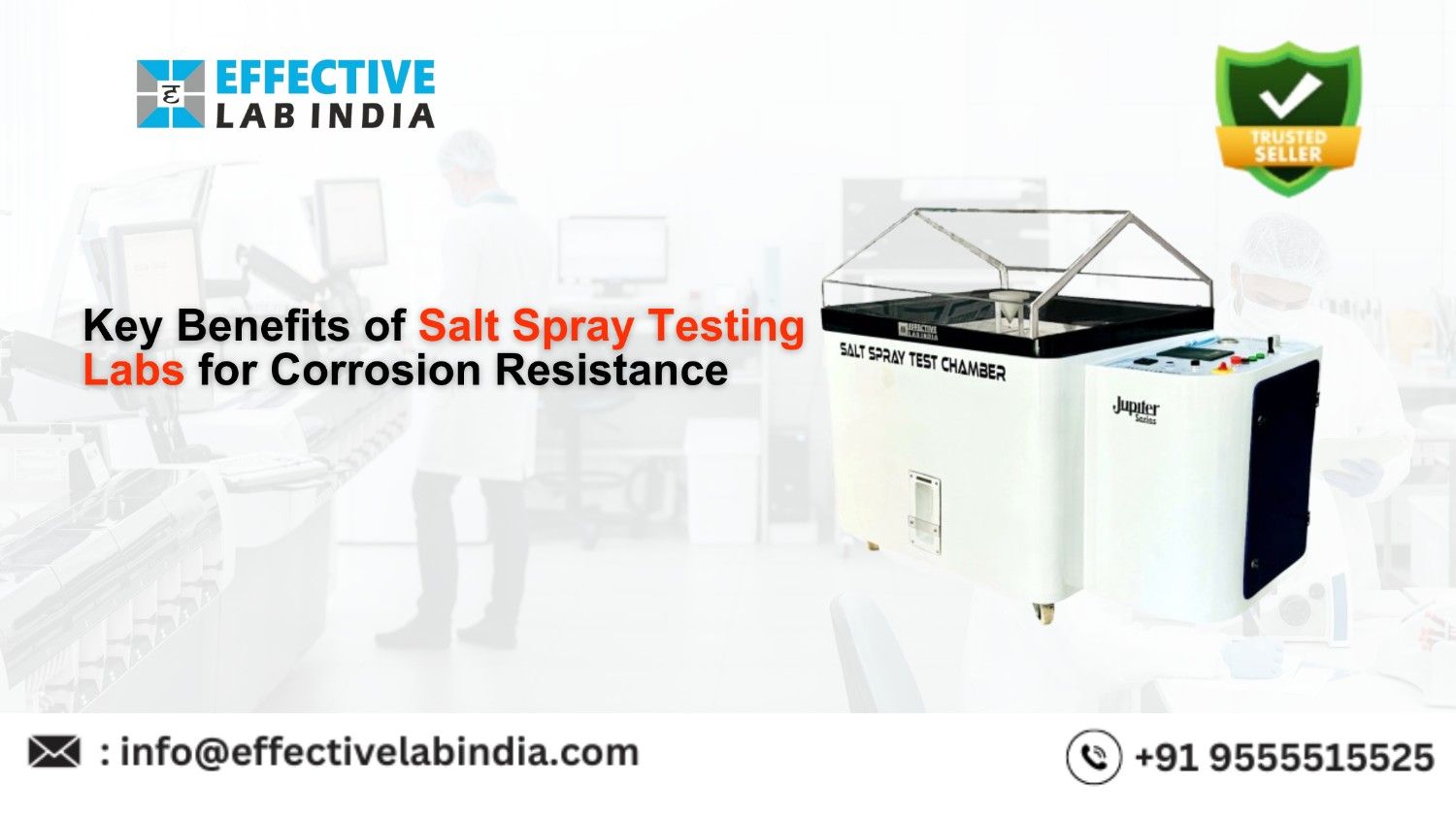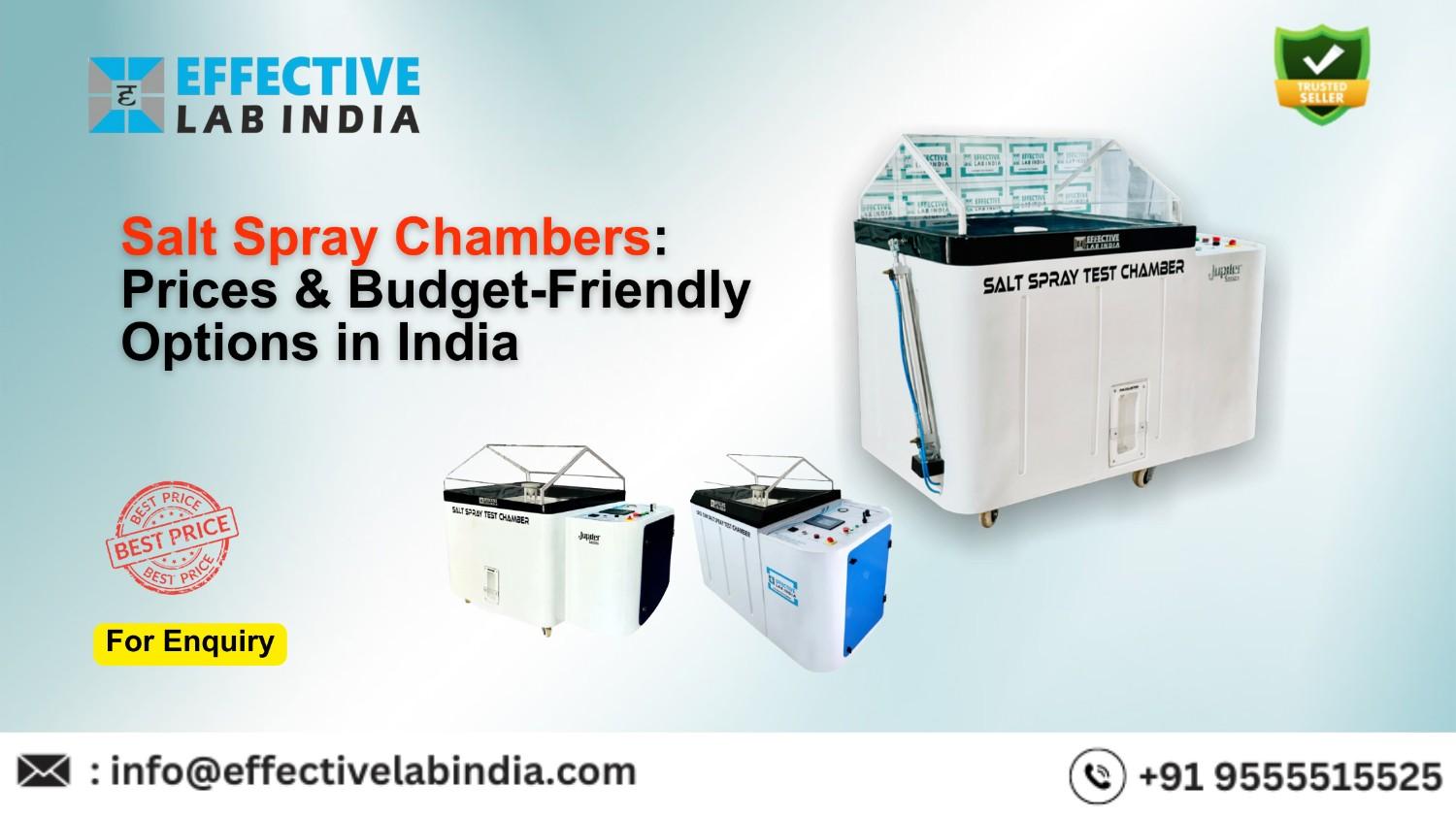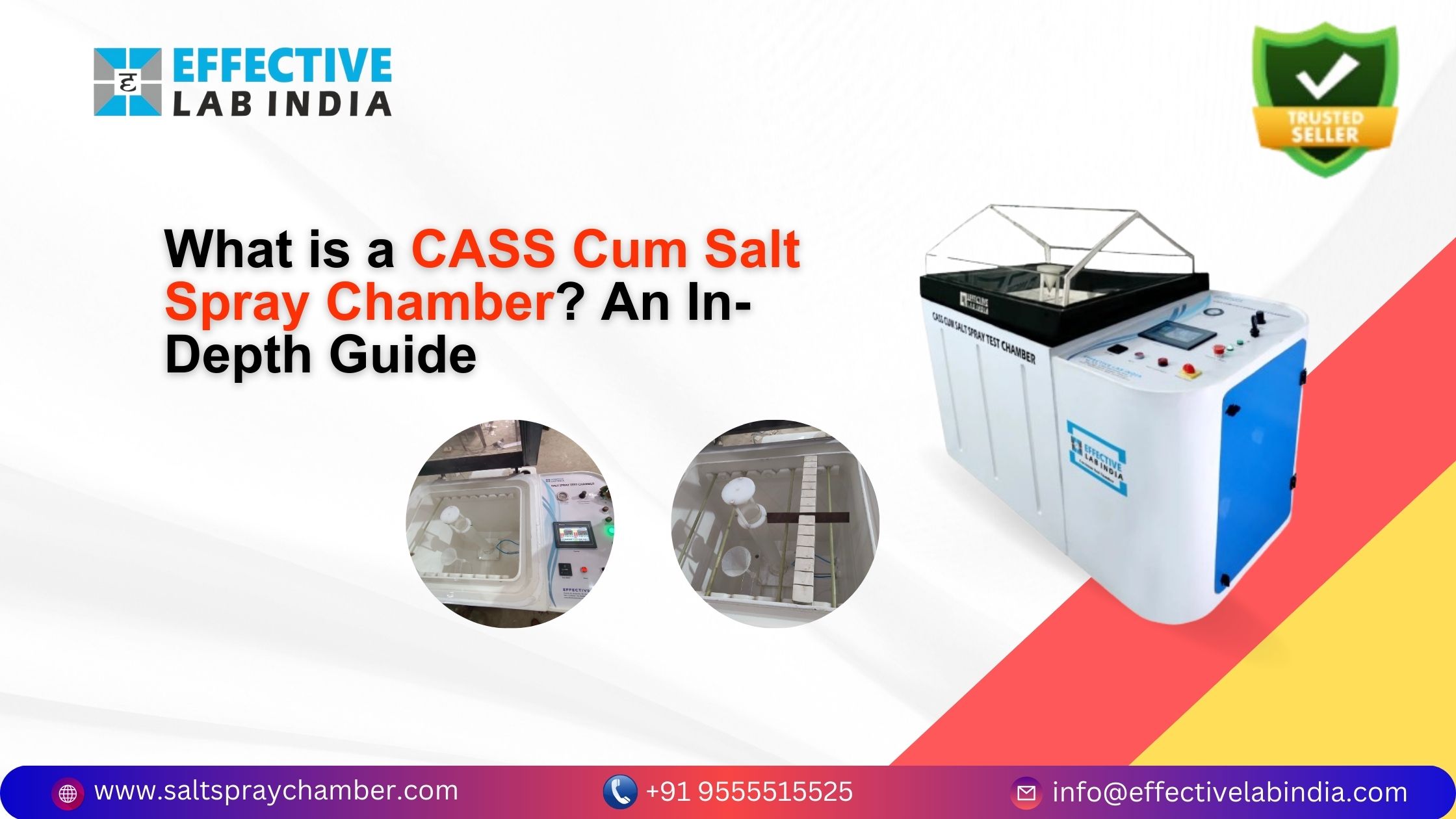Different Test Methods for Testing Metal Using a Salt Spray Chamber

Metal testing is an essential procedure that protects the robustness, dependability, and durability of different supplies utilized in various industries. The need for materials resistant to corrosion has led to the establishing of a salt spray chamber as a crucial instrument for evaluating metal surfaces. Leading testing equipment manufacturer Effective Lab India provides a variety of innovative salt spray chambers to meet a range of metal testing requirements.
What is a Salt Spray Chamber?
A salt spray chamber, also known as a salt fog test chamber, is a specialized piece of equipment used to test the corrosion resistance of metals and coated surfaces. It simulates harsh environmental conditions, like salt-laden atmospheres, to accelerate the corrosion process and assess how metals behave under such conditions.
Salt spray chamber procedure
The test specimens are continually coated with a fine mist, or “spray,” created by atomizing a salt solution in a controlled atmosphere created by the chamber. This configuration simulates the corrosive effects of salty surroundings, such coastlines and roads coated in De-icing salts. It is possible to modify the length and intensity of exposure to meet the unique needs of various exams.
Why Metal Testing is Essential
Corrosion Resistance
Corrosion can severely impact the structural integrity and functionality of metal products. By testing metals in a salt spray chamber, manufacturers can identify potential weaknesses and enhance corrosion resistance, ultimately extending the lifespan of their products.
Quality Assurance
Metal testing is a key aspect of quality assurance, ensuring that products meet the required standards and specifications. This is particularly important in industries where safety and reliability are critical, such as automotive, aerospace, and construction.
Industry Compliance
Many industries are governed by strict regulations that mandate specific testing procedures for metals. Salt spray testing helps companies comply with these standards, avoiding costly penalties and ensuring market access.
Key Test Methods for Metal Testing Using a Salt Spray Chamber
Neutral Salt Spray (NSS) Test
Overview
The Neutral Salt Spray (NSS) test is the most common method used to assess the corrosion resistance of metals and coatings. It involves exposing the test specimens to a neutral pH salt spray environment, typically using a 5% sodium chloride solution.
Procedure
· Prepare the test specimens and ensure they are clean and free of contaminants.
· Place the specimens in the salt spray chamber at a specified angle.
· Set the chamber to continuously spray the salt solution at a controlled temperature, usually around 35°C (95°F).
· Monitor the specimens over a specified period, ranging from hours to weeks, depending on the test requirements.
Applications
The NSS test is widely used in industries like automotive, marine, and construction to evaluate the corrosion resistance of metals, paints, and coatings.
Acetic Acid Salt Spray (AASS) Test
Overview
The Acetic Acid Salt Spray (AASS) test is a variation of the NSS test, where acetic acid is added to the salt solution to lower the pH, creating a more aggressive testing environment.
Procedure
· Mix acetic acid with the sodium chloride solution to achieve a pH of around 3.1.
· Follow the same steps as the NSS test, with the chamber temperature set to 50°C (122°F).
· Observe the specimens for signs of corrosion, such as rust or blistering.
Applications
The AASS test is commonly used for testing metals with protective coatings, such as anodized aluminum, and is particularly relevant in industries where enhanced corrosion resistance is essential.
Copper-Accelerated Acetic Acid Salt Spray (CASS) Test
Overview
The Copper-Accelerated Acetic Acid Salt Spray (CASS) test is an even more aggressive method, incorporating copper chloride into the salt solution to further accelerate the corrosion process.
Procedure
· Add copper chloride to the acetic acid and sodium chloride solution, creating a highly corrosive environment.
· Expose the test specimens to this solution at a chamber temperature of 50°C (122°F).
· Monitor the specimens for signs of rapid corrosion.
Applications
The CASS test is particularly suited for evaluating the corrosion resistance of decorative coatings, such as those found on automotive parts and household fixtures.
Cyclic Corrosion Testing (CCT)
Overview
Cyclic Corrosion Testing (CCT) involves exposing metal specimens to alternating periods of salt spray, humidity, and drying cycles. This method more accurately simulates real-world environmental conditions, making it a valuable tool for assessing long-term corrosion resistance.
Procedure
· Program the chamber to cycle between salt spray, high humidity, and dry air conditions.
· Expose the specimens to these cycles over a predetermined period.
· Evaluate the corrosion patterns that develop over time.
Applications
CCT is widely used in the automotive and aerospace industries, where materials are exposed to varying environmental conditions.
Detailed Overview of NSS, AASS, and CASS Tests
Comparing the Different Approaches
Different degrees of corrosion severity are available for the NSS, AASS, and CASS tests, making them appropriate for a range of applications. Although NSS is the best option for general corrosion testing, more severe conditions that call for increased corrosion resistance are better suited for AASS and CASS.
Appropriate Metal Types for Every Technique
NSS: Appropriate for evaluating metals coated with zinc, aluminum, and steel.
AASS: Optimal for coated metals like galvanized steel and aluminum.
CASS: Perfect for pieces made of metal that have ornamental coatings, such chrome plating.
Elements Affecting Test Outcomes
Metal Content
The metal’s resistance to corrosion is mostly determined by its chemical makeup. For instance, in salt spray testing, stainless steel usually shows superior resistance over carbon steel.
Environmental Conditions
The test’s result may vary depending on the chamber’s temperature, humidity, and salt solution concentration. In these circumstances, consistency is essential to getting trustworthy outcomes.
Test Duration
The rusting gets worse the longer it is exposed to the salt spray. The planned use of the metal product should be taken into consideration when choosing the test period.
Applications of Salt Spray Testing in Various Industries
Automotive Industry
Salt spray testing is essential in the automotive industry to ensure the longevity and safety of vehicles exposed to road salts and harsh weather conditions.
Aerospace Industry
In aerospace, where materials are subjected to extreme environmental conditions, salt spray testing helps in selecting metals that can withstand corrosion over extended periods.
Marine Industry
Marine environments are highly corrosive due to the presence of saltwater. Salt spray testing is crucial for ensuring the durability of metals used in ships, offshore platforms, and other marine structures.
Construction Industry
Salt spray testing is used in the construction industry to evaluate the corrosion resistance of metals used in building structures, bridges, and other infrastructure.
Advantages of Using a Salt Spray Chamber for Metal Testing
Accurate Simulation of Real-World Conditions
Salt spray chambers provide a controlled environment that accurately simulates the corrosive effects of real-world conditions, making it easier to predict how metals will perform in the field.
Cost-Effective Testing
Compared to other testing methods, salt spray testing is relatively cost-effective, providing valuable data without the need for expensive field tests.
Rapid Results
Salt spray testing accelerates the corrosion process, allowing manufacturers to obtain results quickly and make timely decisions regarding material selection and product design.
Effective Lab India’s Expertise in Salt Spray Chambers
Modern Salt Spray Chambers with the Newest Technology Available from Effective Lab India Provide exact control over testing parameters and precise outcomes.
Effective Lab India offers customization options to customize their salt spray chambers to individual specifications, acknowledging that various sectors have distinct testing requirements. Effective Lab India’s salt spray chambers are well-received by customers who attest to their dependability and efficiency. This underscores the company’s dedication to excellence and client contentment.
Choosing the Right Salt Spray Chamber for Your Needs
Key Considerations
When selecting a salt spray test chamber, consider factors such as the size of the chamber, the type of metals you are testing, and the specific test methods you plan to use.
Recommendations from Effective Lab India
Effective Lab India offers expert guidance in choosing the right salt spray chamber, ensuring that you invest in equipment that meets your testing needs and delivers accurate results.
Conclusion
An essential technique for evaluating the corrosion resistance of metals and coatings is salt spray testing. Making educated judgments on material selection and product design will be aided by knowing the various test techniques and their applications, regardless of your industry: construction, automotive, aerospace, or maritime. The cutting-edge salt spray chambers from Effective Lab India provide the accuracy and dependability required for comprehensive metal testing.




